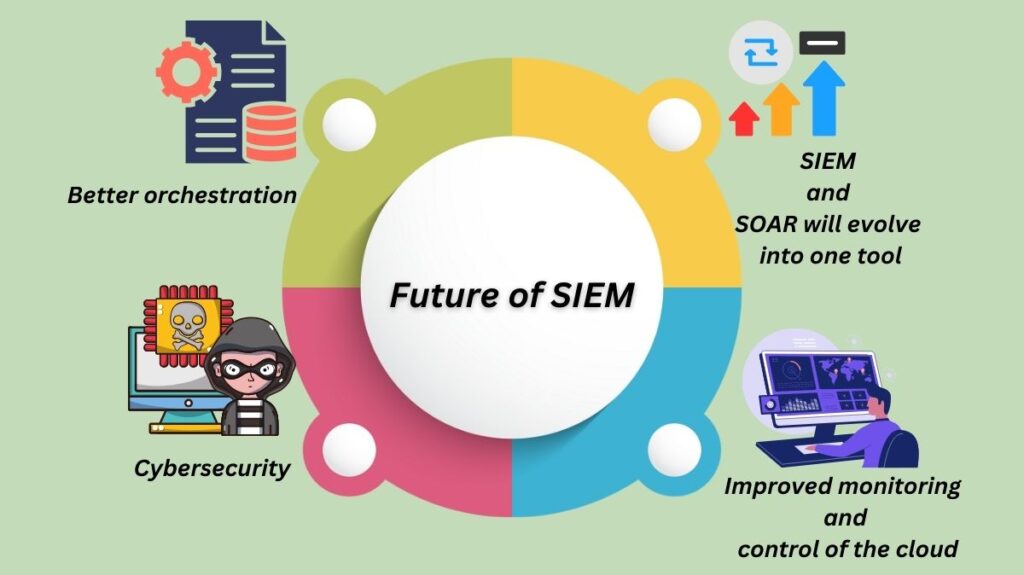Future of SIEM

The following are some future developments in SIEM:
Better orchestration
Security information and event management(SIEM) now only offers businesses rudimentary workflow automation. However, SIEM needs to provide more features as these organizations expand. For instance, SIEM technologies need to enable quicker orchestration with AI and machine learning in order to give all departments in a firm the same degree of security. Furthermore, security procedures and their implementation will be more rapid, efficient, and effective.
Cybersecurity
Improved cooperation using technologies for managed detection and response (MDR). It’s critical that businesses use a two-tiered strategy to identify and assess security threats as the likelihood of hacking and unauthorized access keeps rising. While the MDR tool may be implemented by a managed service provider, SIEM can be implemented internally by a company’s IT staff.
Improved monitoring and control of the cloud
To better satisfy the security requirements of enterprises that use the cloud, SIEM providers will enhance the cloud administration and monitoring features of their products.
SIEM and SOAR will evolve into one tool
To profit from SOAR, look for classic SIEM products; however, SOAR suppliers will probably increase their product capabilities in response.
The following five outcomes might be part of SIEM’s future, per a recent Forbes article:
- SIEM pricing methods based on use will proliferate.
- Universal SIEM data platforms will serve as the foundation for the analysis tools.
- Companies will collaborate to offer further integrations.
- Security information and event management(SIEM) will become more accessible for smaller security teams as its cost decreases.
Startups will tackle more of the complex security management issues.
How to Choose a SIEM Provider
Every SIEM system on our above list is a reliable option with a large user base. Consider the vendor’s history and position in the market when choosing a SIEM, and focus especially on functionality.
In order to increase a SIEM’s effectiveness for your company, we’ve included both basic features that define a SIEM solution and next-generation capabilities that offer automation and intelligence. The top SIEM systems include next-generation features that are appropriate for your security requirements while still covering the essential functions.
Core SIEM Capabilities
Threat detection
Using rules and behavior analytics, SIEMs offer precise threat detection. They also compile geolocations, backlists, and threat feeds.
Threat intelligence and security alerting
Numerous SIEMs link your security system to a threat intelligence feed for security alerts and threat information. This guarantees that your company is aware of the most recent cyberthreats. By evaluating your system activity, cross-checking many sources, and notifying you whenever they see a questionable event, SIEMs also compile and normalize your security data.
Assessment and reporting of compliance
One of the largest challenges facing every company is compliance, which is only becoming more complicated. Regulations like PCI, HIPAA, and FFIEC specify what data must be stored and how. A firm may suffer disastrous consequences if regulatory obligations are not met. SIEMs offer compliance reporting and can assist you in determining how well your company complies with legal obligations.
Real-time notifications
SIEMs will alert you immediately of any security breaches since, when it comes to security, time is of the importance. This enables your company to react to a possible danger right away.
The most crucial component of SIEM is data aggregation, which centralizes information from several sources and gives you a comprehensive view of all your network activity. In the absence of this, it would be simple to overlook obscure areas inside your network, particularly as your company expands. Cybercriminals may readily take advantage of this lack of awareness, making your network susceptible to undetected intrusion.
Data normalization
There are a lot of data from many sources in your security system. All of this information must be structured consistently in order to find similarities in security events. All of your security data is normalized by SIEM, which facilitates analysis and allows you to derive valuable insights.
Next-Gen SIEM Capabilities
Data collection and management
Next-generation data collecting and management With the use of integrated connections, SIEMs are able to gather and handle data from any source. Cloud resources and services, network and on-premise log data, and external devices like cellphones are the key categories of data sources.
Cloud delivery
Cloud SIEMs make use of data lakes and elastic cloud storage. Because of this, they are far more scalable than conventional, on-premise SIEMs, which depend on hardware that is unable to manage the enormous amounts of data produced by big businesses.
User and Entity Behavior Analysis (UEBA)
By creating a baseline of normal user behavior, User and Entity Behaviors Analysis (UEBA) use machine learning techniques to spot behavioral irregularities. Modern SIEMs can now efficiently identify insider and zero-day attacks with to this technique, which doesn’t match established attack signatures.
Security Orchestration and Automation Response (SOAR)
Instead than only monitoring and alerting, SIEMs may react to security problems as they happen with to Security Orchestration and Automation Response (SOAR). By suggesting pertinent actions, next-generation SIEMs may work directly with IT and security infrastructure. Additionally, they may coordinate threat detection and response technologies utilized by various systems, automate threat response via the use of IR playbooks, and oversee security systems including email servers, firewalls, and access control.
Automated attack timelines
In order to understand the attack chronology, analysts using standard SIEMs must compile information from many sources. This calls for specialized knowledge and might take a lot of time. An attack chronology can be automatically created by next-generation SIEMs and shown graphically for analysts with less expertise. Investigation and incident triage go considerably more quickly as a result.
